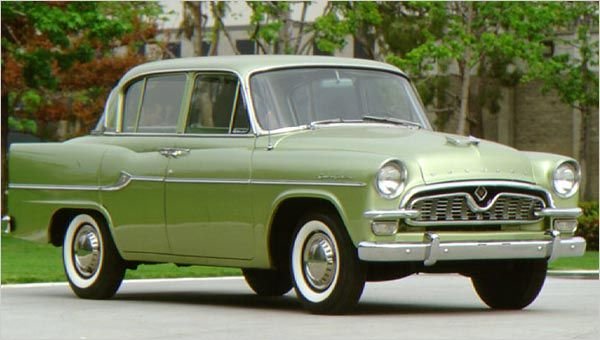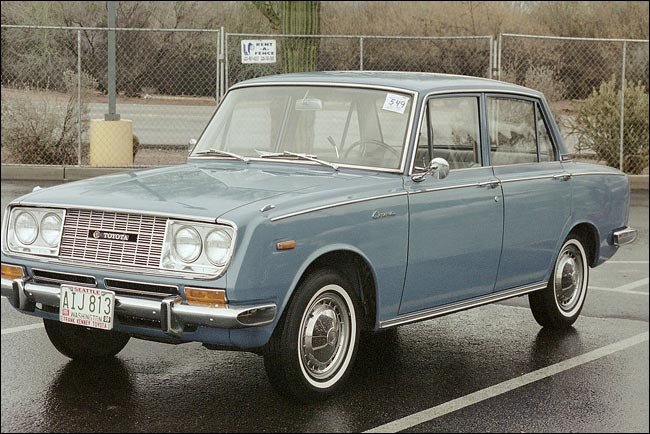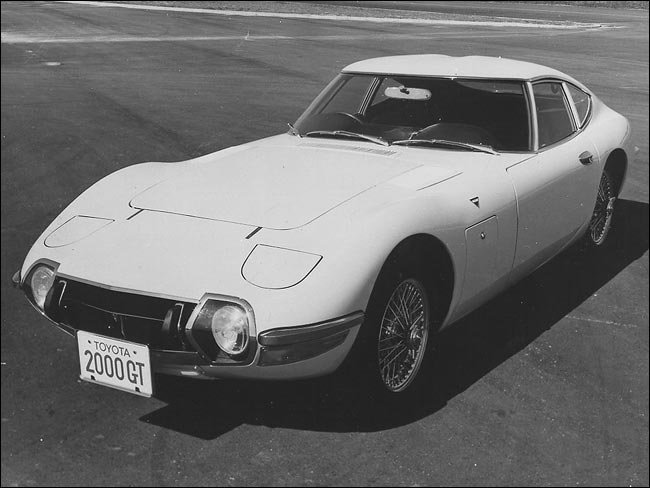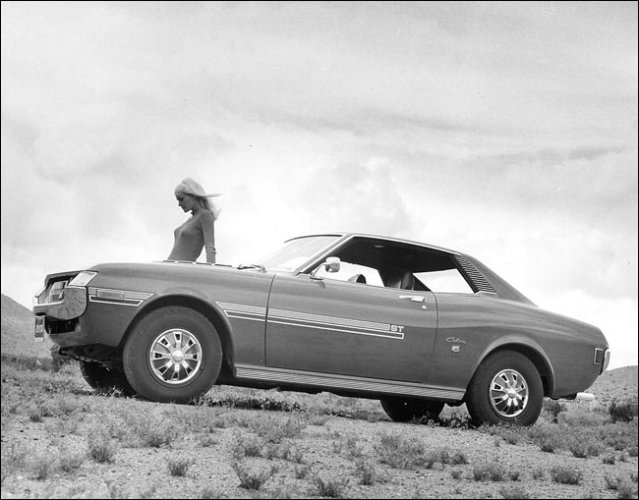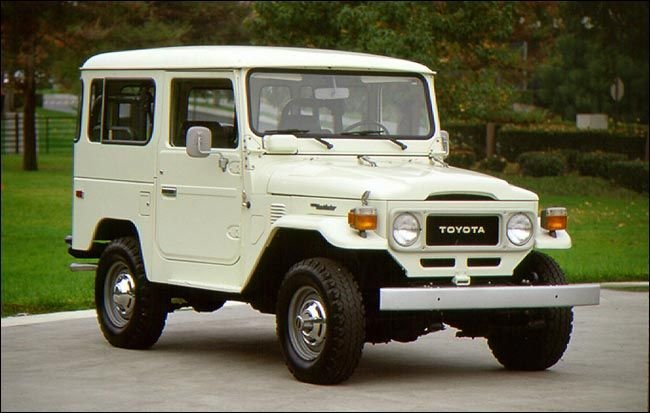New-Generation Collectors Give Toyota Some Respect
By ROB SASS
From the NY Times
ONE of the few automotive niches where Toyota does not yet have a strong presence is the collector car market. Fifty years after its first troubled attempts to bring cars to American roads, there are signs that this may be changing: quietly, and outside the usual collector car circles, a groundswell of interest in vintage Toyotas has been building.
One of the most talked-about cars to appear at collector car auctions early this year was a frumpy Toyota family sedan, a 1966 four-door Corona that had been purchased in 1970 by Frank Kenney, one of the first Toyota dealers in the state of Washington. After paying $800 to buy the barely driven sedan from an elderly Seattle woman, he used the car as a showroom display rather than resell it.
Frank Kenney’s son, Jerome, joked that some day he would drive the pastel blue Corona to his father’s funeral, and did just that when his father died last August. Its duty fulfilled, he consigned the beautifully preserved Toyota to the Silver Auction sale in Fort McDowell, Ariz., in January. Its odometer showed just 8,768 miles.
For a nondescript econocar, the Corona caused a minor sensation. Many auctiongoers had never seen a Toyota from the 1960s. No wonder — a lack of rustproofing assured a survival rate for those early Toyotas that was only slightly better than that of a passenger pigeon. The bidding quickly sailed past the reserve of $12,000, and when the hammer fell, it had reached $16,740.
Interest in sportier Toyota models has also been growing. Joji Luz lives in the epicenter of the nascent Japanese collector car market — Southern California — and his enthusiasm for the Toyota marque is more typical of what you might expect to encounter at a Porsche or Corvette club meeting. Mr. Luz, who grew up in Manila, discovered the thrift and durability of Toyotas when his father’s taxi fleet changed over to the Japanese imports.
Today, Mr. Luz owns 12 vintage Toyotas, including the fifth and 13th Celicas made, and he’s aware of virtually every early Celica that comes on the market in California. Mr. Luz pegs the value of a stock, well-restored 1971-72 Celica at around $12,000. They can bring thousands more if modified with the dual-cam engine that was fitted to cars sold in the Japanese market.
The Celica was among the first Japanese entries into the sporty personal car market; a Liftback version showed a marked resemblance to a scaled-down 1967 Mustang. In stock form, the first-generation Celica (1970-77) was a modest performer. Most road tests reported 0-to-60 acceleration times for the Celica from 11 to 13 seconds, about the same as an MGB or Fiat Spider of the era.
But the Celica could outhandle both of those sports cars. Road & Track’s review of a 1974 Celica GT reported that the Toyota was quicker through a slalom course than any other car it had tested except one — a Ferrari Dino.
The Celica also had enormous potential for hot-rodding. Janet Guthrie, an aspiring racecar driver who would become the first woman to compete in the Indianapolis 500, purchased a 1972 Celica — the first new car she had ever owned — and proceeded to take it apart and turn it into a racecar. She raced the car 51 times from 1973-75. In the car’s final race under her ownership, Ms. Guthrie passed 20 cars in fewer than five laps to move into second place and on the final lap, passed an MGB for the win.
Robert Pass, a vintage car dealer in St. Louis, later owned the Guthrie Celica, racing it in the 1990s. “It was a delightful racecar,” he said. “Its handling was as neutral and pleasant as any Alfa Romeo.”
That statement might be considered heresy by traditional collectors. And there lies the rub with Japanese cars as collectibles: the old guard in the collector car world gives them no respect. A car like an early Celica, while stylish, well-built and as entertaining to drive as its contemporaries from Europe, has a hard time being taken seriously. Mr. Pass said that it boiled down to the perception that Japanese cars lacked the heritage and cachet of European cars.
But the post-baby boomers who grew up with Japanese cars seem to care little what traditional collectors think, as evidenced by the growing number of gatherings devoted to Japanese cars. Twelve years ago, when the Toyota Owners and Restorers Club in Long Beach, Calif., started Toyotafest, it was a 10-car get-together. Terry Yamaguchi, the club’s director for special events, expects more than 300 Toyotas at this year’s event on May 12.
David Swig, a promoter of Motoring J Style, a Vallejo, Calif., all-Japanese car festival to be held on July 28, is also betting that Japanese cars will be the next big thing in collectibles. Mr. Swig said the event would be the first in the United States to include a judged concours d’élégance exclusively for vintage Japanese cars.
Perhaps the most collectible Toyotas of all, at least in the United States, are the FJ series Land Cruisers. The FJ40 model, available in the United States in 1960-83, is by far the most popular among collectors of classic Land Cruisers. Rusty examples are still available for less than $5,000, but clean originals bring $17,000 to $20,000 and professionally restored FJ40s start at more than $30,000. Prices go up from there, depending on how fresh the restoration is and whether it was done by a well-known Land Cruiser specialist like TLC Inc. in Van Nuys, Calif., where restorations can cost up to $85,000.
Land Cruisers have a mystique all their own that conjures up exotic locales like Africa or the Andes. According to Jonathan Ward, who owns TLC with his wife, Jamie, vintage Land Cruisers resonate with anyone who has spent a lot of time in remote parts of the world where they are often the only form of motorized transport.
And like other memorable vehicles, the Land Cruiser refuses to die; Toyota’s new FJ Cruiser was inspired by the classic FJ40.
If there is a holy grail for Toyota collectors, it is the 2000GT. Only 351 of these striking handbuilt sports cars were produced from 1967 to 1970.
The quality of the 2000GT would now rival a Lexus, as would the price. In 1967, a new 2000GT cost more than $7,000 — as much as a 1967 Porsche 911S and almost $2,000 more than a new Jaguar E-Type. Buyers were not ready for a Japanese car that expensive, no matter how good, and the 2000GT disappeared quietly after only three years. But today, a good one commands nearly a quarter of a million dollars.
The 2000GT story has an interesting footnote. In 1968, Carroll Shelby prepared a team of 2000GTs for Sports Car Club of America production-class racing. He was impressed enough to inquire about obtaining a Toyota dealership. The December 1999 issue of Car and Driver magazine blamed Shelby’s good friend Lee Iacocca for talking Shelby out of it, by boasting that the Big Three would kick them “into the Pacific Ocean.”
With products like the Ford Granada, the Chrysler Cordoba, the infamous K-Car and the Dodge Omni to do so, Mr. Iacocca’s statement would prove laughable, especially as Toyota’s sales have passed those of Mr. Iacocca’s former employers, Ford and Chrysler.
By ROB SASS
From the NY Times
ONE of the few automotive niches where Toyota does not yet have a strong presence is the collector car market. Fifty years after its first troubled attempts to bring cars to American roads, there are signs that this may be changing: quietly, and outside the usual collector car circles, a groundswell of interest in vintage Toyotas has been building.
One of the most talked-about cars to appear at collector car auctions early this year was a frumpy Toyota family sedan, a 1966 four-door Corona that had been purchased in 1970 by Frank Kenney, one of the first Toyota dealers in the state of Washington. After paying $800 to buy the barely driven sedan from an elderly Seattle woman, he used the car as a showroom display rather than resell it.
Frank Kenney’s son, Jerome, joked that some day he would drive the pastel blue Corona to his father’s funeral, and did just that when his father died last August. Its duty fulfilled, he consigned the beautifully preserved Toyota to the Silver Auction sale in Fort McDowell, Ariz., in January. Its odometer showed just 8,768 miles.
For a nondescript econocar, the Corona caused a minor sensation. Many auctiongoers had never seen a Toyota from the 1960s. No wonder — a lack of rustproofing assured a survival rate for those early Toyotas that was only slightly better than that of a passenger pigeon. The bidding quickly sailed past the reserve of $12,000, and when the hammer fell, it had reached $16,740.
Interest in sportier Toyota models has also been growing. Joji Luz lives in the epicenter of the nascent Japanese collector car market — Southern California — and his enthusiasm for the Toyota marque is more typical of what you might expect to encounter at a Porsche or Corvette club meeting. Mr. Luz, who grew up in Manila, discovered the thrift and durability of Toyotas when his father’s taxi fleet changed over to the Japanese imports.
Today, Mr. Luz owns 12 vintage Toyotas, including the fifth and 13th Celicas made, and he’s aware of virtually every early Celica that comes on the market in California. Mr. Luz pegs the value of a stock, well-restored 1971-72 Celica at around $12,000. They can bring thousands more if modified with the dual-cam engine that was fitted to cars sold in the Japanese market.
The Celica was among the first Japanese entries into the sporty personal car market; a Liftback version showed a marked resemblance to a scaled-down 1967 Mustang. In stock form, the first-generation Celica (1970-77) was a modest performer. Most road tests reported 0-to-60 acceleration times for the Celica from 11 to 13 seconds, about the same as an MGB or Fiat Spider of the era.
But the Celica could outhandle both of those sports cars. Road & Track’s review of a 1974 Celica GT reported that the Toyota was quicker through a slalom course than any other car it had tested except one — a Ferrari Dino.
The Celica also had enormous potential for hot-rodding. Janet Guthrie, an aspiring racecar driver who would become the first woman to compete in the Indianapolis 500, purchased a 1972 Celica — the first new car she had ever owned — and proceeded to take it apart and turn it into a racecar. She raced the car 51 times from 1973-75. In the car’s final race under her ownership, Ms. Guthrie passed 20 cars in fewer than five laps to move into second place and on the final lap, passed an MGB for the win.
Robert Pass, a vintage car dealer in St. Louis, later owned the Guthrie Celica, racing it in the 1990s. “It was a delightful racecar,” he said. “Its handling was as neutral and pleasant as any Alfa Romeo.”
That statement might be considered heresy by traditional collectors. And there lies the rub with Japanese cars as collectibles: the old guard in the collector car world gives them no respect. A car like an early Celica, while stylish, well-built and as entertaining to drive as its contemporaries from Europe, has a hard time being taken seriously. Mr. Pass said that it boiled down to the perception that Japanese cars lacked the heritage and cachet of European cars.
But the post-baby boomers who grew up with Japanese cars seem to care little what traditional collectors think, as evidenced by the growing number of gatherings devoted to Japanese cars. Twelve years ago, when the Toyota Owners and Restorers Club in Long Beach, Calif., started Toyotafest, it was a 10-car get-together. Terry Yamaguchi, the club’s director for special events, expects more than 300 Toyotas at this year’s event on May 12.
David Swig, a promoter of Motoring J Style, a Vallejo, Calif., all-Japanese car festival to be held on July 28, is also betting that Japanese cars will be the next big thing in collectibles. Mr. Swig said the event would be the first in the United States to include a judged concours d’élégance exclusively for vintage Japanese cars.
Perhaps the most collectible Toyotas of all, at least in the United States, are the FJ series Land Cruisers. The FJ40 model, available in the United States in 1960-83, is by far the most popular among collectors of classic Land Cruisers. Rusty examples are still available for less than $5,000, but clean originals bring $17,000 to $20,000 and professionally restored FJ40s start at more than $30,000. Prices go up from there, depending on how fresh the restoration is and whether it was done by a well-known Land Cruiser specialist like TLC Inc. in Van Nuys, Calif., where restorations can cost up to $85,000.
Land Cruisers have a mystique all their own that conjures up exotic locales like Africa or the Andes. According to Jonathan Ward, who owns TLC with his wife, Jamie, vintage Land Cruisers resonate with anyone who has spent a lot of time in remote parts of the world where they are often the only form of motorized transport.
And like other memorable vehicles, the Land Cruiser refuses to die; Toyota’s new FJ Cruiser was inspired by the classic FJ40.
If there is a holy grail for Toyota collectors, it is the 2000GT. Only 351 of these striking handbuilt sports cars were produced from 1967 to 1970.
The quality of the 2000GT would now rival a Lexus, as would the price. In 1967, a new 2000GT cost more than $7,000 — as much as a 1967 Porsche 911S and almost $2,000 more than a new Jaguar E-Type. Buyers were not ready for a Japanese car that expensive, no matter how good, and the 2000GT disappeared quietly after only three years. But today, a good one commands nearly a quarter of a million dollars.
The 2000GT story has an interesting footnote. In 1968, Carroll Shelby prepared a team of 2000GTs for Sports Car Club of America production-class racing. He was impressed enough to inquire about obtaining a Toyota dealership. The December 1999 issue of Car and Driver magazine blamed Shelby’s good friend Lee Iacocca for talking Shelby out of it, by boasting that the Big Three would kick them “into the Pacific Ocean.”
With products like the Ford Granada, the Chrysler Cordoba, the infamous K-Car and the Dodge Omni to do so, Mr. Iacocca’s statement would prove laughable, especially as Toyota’s sales have passed those of Mr. Iacocca’s former employers, Ford and Chrysler.

